SOHAM GRAMMAR SCHOOLpresents The Bartered BrideAn Opera in Three Acts by FREDERIC SMETANA Friday 20th March, 1959 |
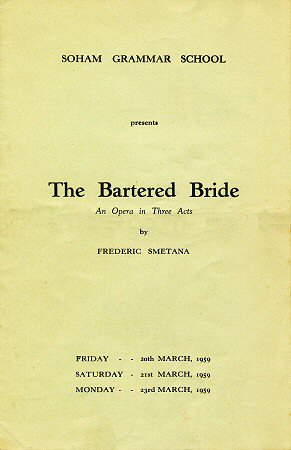 |
SOHAM GRAMMAR SCHOOLpresents The Bartered BrideAn Opera in Three Acts by FREDERIC SMETANA Friday 20th March, 1959 |
 |
CHARACTERS
Landlord - J GRASSI
Krusina, a peasant - M HUMAN
Ludmila, his wife - A CHRISTIE
Marenka, their daughter - S POOLE
Micha, a peasant - D CROWE
Hata, his second wife - N LONG
Vasek, her son - D BANYARD
Jenik, son of Micha's first wife - J NEWMAN
Kecal, village marriage broker - R HINZE
Circus Manager - B HALLS
Esmeralda - W TINGEY
The Indian - M MORTONCHORUS OF VILLAGERS
E Bailey, A Blythe, R Bolton, B Bowles, T Boyden,
R Brignell, D Burtt, R Butcher, A Butler, M Coe, R Creak,
A Cullum, T Day, G Jenkinson, W Kelly, A Pauley,
G Pryke, A Sear, E Smith, M Strevens, M Stuart, A Warne,
A Watson, I White, R Wheeler, P Vaissiere;
B Alps, R Barber, P Boyce, C Bull, M Bunting, E Coe,
J Couperthwaite, E Cox, R Dewsbury, J Gothard,
D Griffin, G Hemmings, A Hill, J Hollands, R Jennings,
A Mann, M Tester, M Whymer, M Wilson, A Yardy.CIRCUS TROUPE
A Breeze, M Brickwood, C Capes, G Davis, R Ellingham,
M Lister, G Murfet, M Pollard, G Rouse, B Ward,
I Whymer, B Wilson.SCENE
A Courtyard of a Bohemian village inn during the Spring festival at the beginning of the nineteenth century.There will be intervals of ten minutes between Acts I and II and Acts II and III.
The National Anthem will be played at the conclusion of the Opera.
Set and costumes designed by PJ Askem, Esq Set construction by EH Tabraham, Esq, M Bunting, GT Bye, P Grange, I Marshall, D Sennitt.
Set Painted by M Hallam, R Darby, R Meadows, J Starling
Lighting by G Parrott, Esq, R Murrell, J Chalkley, E Maffey
Stage Assistants: M Pamment, W Docherty, R Smith
Costume Manager: RJ Housden, Esq
Make-up by M Hallam, D Crowe, M Pamment, B Burling,
G Langford, M Shaw, W Docherty, R Register, R SmithThe Musicians:
THE MACNAGHTEN STRING QUARTET
Leader: ANNE MACNAGHTEN, Second Violin: BERNARD BLAY
Viola: PAULINE JACKSON, Violoncello: ARNOLD ASHBYDirector of Music: WH Stalker, Esq
Producer: CR Waller, Esq
Our most grateful thanks are due to the many ladies who have
given (not for the first time in school productions) such valuable
and such welcome assistance with the costumes.Our thanks are also due to Mr Ludovic Stewart, County Music
Adviser, for his advice and co-operation throughout the production.SYNOPSIS
ACT I.
All the villagers are rejoicing at the Spring festival, except Marenka ; she loves Jenik, a mysterious handsome new comer to the village, but her parents (at the suggestion of Kecal, the marriage-broker) have decided that she must marry a young man she has never seen, the son of Tobias Micha. She tells her parents and Keeal that she will marry no-one but Jenik.
ACT II.
Marenka meets Vasek, the slow-witted son of Tobias Micha's second wife, and recognises him as her intended husband. As he does not recognise her, she is able to paint so unflattering a picture of herself that Vasek promises to have nothing to do with his bride-to-be. Kecal, anxious not to lose his commission on the forthcoming marriage, attempts to interest Jenik in another girl ; Jenik will hear nothing of her, but at last when Kecal offers him three hundred crowns to renounce Marenka, he agrees to do so. The document he signs is so worded that Marenka, must marry "the son of Tobias Micha". Jenik alone knows that he (as the son of Micha's first marriage who has grown up away from the village) qualifies for this description. He thus takes little notice of the villagers' accusations that he has bartered Marenka for gold.
ACT III.
A travelling circus arrives at the village. Vasek immediately falls in love with Esmeralda, the dancer of the circus; she persuades him to take the place of the man who usually plays the performing bear, but who is too drunk to perform. Vasek's parents want him to meet Marenka, but he refuses. Just as Marenka, heart-broken by Jenik's apparent callousness, has decided that she will consent to marry Vasek, Vasek's father, Tobias Micha, recognises Jenik as the son of his first marriage. So Kecal has been outwitted, and the lovers are united. The news that a bear has escaped from the circus only adds to the general merry-making when it is discovered that it is only Vasek who is inside the bear-skin.
From THE TIMES
BOHEMIA TRANSPLANTED School productions of opera hardly differ from the more professional kind in promising more than they can achieve. But the proof of the announcement lies, as always, in the performance, and the recent production of Smetana's comic masterpiece The Bartered Bride at the Soham Grammar School, Cambridgeshire, offered a pointed warning against the folly of preconceptions. Who, for example, would have believed that a Bohemian village could be so painlessly transplanted in a school near Newmarket? Or, for that matter, that a piano and string quartet, however excellent the performers, could reproduce the felicities of Smetana's colourful orchestration? The obvious impossibility of his undertaking so eluded the school's musical director, Mr. W.H. Stalker, that he found that the readiest of all solutions lay in simply ignoring the difficulties. In the resulting enchantment a schoolboy Marenka was transformed into a Slavonic heroine whom even experts (and this was put to the test) could not tell apart from the real thing! Relieved only of her fine scena in the Third Act, this Marenka made even the occasional hesitations of a treble that was nearing the end of its career infuse character into her emotion-filled cantilena. Jenik, her loving tormentor, cut a handsome figure and sang his part gracefully. |
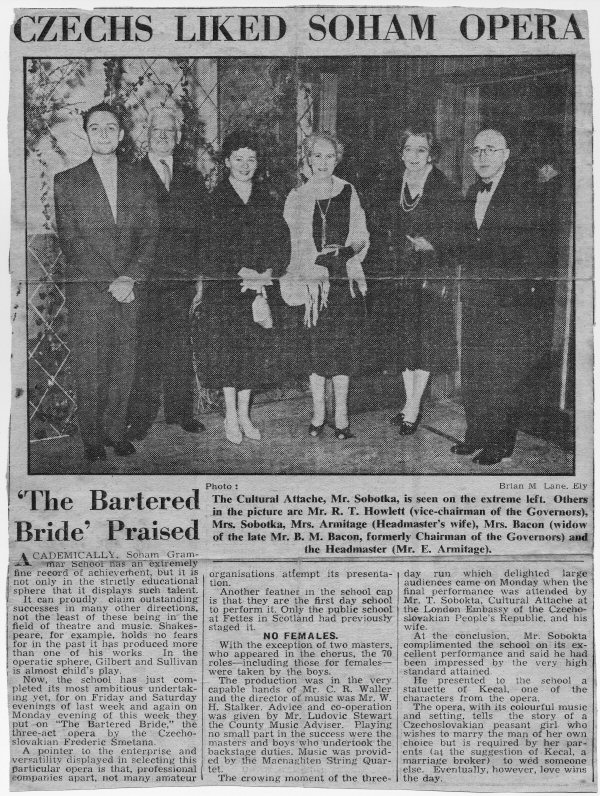
via Norman Long, publication unknown
CZECHS LIKED SOHAM OPERA
Photo : Brian M Lane, Ely
The Cultural Attache, Mr. Sobotka, is seen on the extreme left. Others in the picture are Mr. RT Howlett (vice-chairman of the Governors), Mrs Sobotka, Mrs Armitage (Headmaster's wife), Mrs Bacon (widow of the late Mr BM Bacon, formerly Chairman of the Governors) and the Headmaster (Mr E Armitage)'The Bartered Bride' Praised
Academically, Soham Grammar School has an extremely fine record of achievement, but it is not only in the strictly educational sphere that it displays such talent. It can proudly claim outstanding successes in many other directions, not the least of these being in the field of theatre and music. Shakespeare for example, holds no fears for in the past it has produced more than one of his works. In the operatic sphere, Gilbert and Sullivan is almost child's play.
Now, the school has just completed its most ambitious undertaking yet, for on Friday and Saturday evenings of last week and again on Monday evening of this week they put on "The Bartered Bride," the three-act opera by the Czechoslovakian Frederic Smetana. A pointer to the enterprise and versatility displayed in selecting this particular opera is that, professional companies apart, not many amateur organisations attempt its presentation. Another feather in the school cap is that they are the first day school to perform it. Only the public school at Fettes in Scotland had previously staged it.
NO FEMALES.
With the exception of two masters, who appeared in the chorus, the 70 roles - including those for females - were taken by the boys.
The production was in the very capable hands of Mr CR Waller and the director of music was Mr WH Stalker. Advice and co-operation was given by Mr. Ludovic Stewart the County Music Adviser. Playing no small part in the success were the masters and boys who undertook the backstage duties. Music was provided by the Macnaughten String Quartet.The crowning moment of the three-day run which delighted large audiences came on Monday when the final performance was attended by Mr T Sobokta, Cultural Attache at the London Embassy of the Czechoslovakian People's Republic, and his wife. At the conclusion, Mr Sobokta complimented the school on its excellent performance and said he had been impressed bv the very high standard attained. He presented to the school a statuette of Kecal, one of the characters from the opera.
The opera, with its colourful music and setting, tells the story of a Czechoslovakian peasant girl who wishes to marry the man of her own choice but is required by her parents (at the suggestion of Kecal, a marriage broker) to wed someone else. Eventually, however, love wins the day.
via Norman Long, publication unknownAn outstanding production
Following upon the success of their production last year of "The Gondoliers", Soham Grammar School have this year scored another triumph by tackling Smetana's opera "The Bartered Bride"
[Mr Sobotka hands the statuette to the headmaster.]To face up to the demands of a work of this kind calls for a high spirit of adventure and not a little courage. It is not an easy undertaking, even for competent artistes, and it is remarkable that a bunch of schoolboys should put on such performances as were enjoyed by large audiences on Friday, Saturday and Monday.
With typical schoolboy irrelevance [sic] it was inevitably referred to as "The Battered Bride" and cynics might have been prepared, in all the circumstances, to find that "battered" was the operative word - but how wrong they would have been! Everything considered it was an incredible production and nothing but the highest praise is due to all those who were responsible.
TEAM WORK
It was again essentially a school effort - a striking example of what can be achieved by team work. The principal architects of the production were the accomplished producer, Mr CR Waller and the director of music, Mr WH Stalker, and the way in which the boys responded was reflected in results; with everyone of the 70-strong cast pulling his weight, it would be invidious to single out individuals for special mention. Each one, whether principal or a member of the chorus, put everything he knew into his particular part, and such a response must have been very heartwarming to those who made the decision to tackle a work which had never before been performed in this country by a boys' day school.COLOURFUL SPECTACLE
It was an extremely colourful spectacle, with the gay costumes set against a background of the courtyard of a Bohemian village inn during the, Spring festival. The excellent stage set and costumes were designed by Mr PJ Askem, the former being constructed by boys of the school, while the 'mums' gave valuable assistance in the making of the costumes.For the production the school had the assistance of the Macnaghten String Quartet. They were housed in a musicians' gallery, which was part of the set, and this meant that the singers had their backs to the musicians. This did not make things any easier for them, in view of the tricky nature of some of the numbers, but they took the absence of a visible conductor in their stride.
THE CAST
The cast comprised: Landlord, J Grassi; Krusina, a peasant, M Human; Ludmila, his wife, A Christie; Marenka, their daughter, S Poole; Micha, a peasant, D Crowe; Hata, his second wife, [N Long]; Vasek, her son, D Banyard; Jenik, son of Micha's first wife, J Newman; Kecal, village marriage broker, R Hinze; circus manager, B Halls; Esmeralda, W Tingey; Indian, M Morton.Chorus of villagers - E Bailey, A Blythe, R Bolton, B Bowles, T Boyden, R Brignell, D Burrt, R Butcher, A Butler, M Coe, R Creak, A Cullum, T Day, G Jenkinson, W Kelly, A Pauley, G Pryke, A Sear, E Smith, M Strevens, M Stuart, A Warne, A Watson, I White, R Wheeler, P Vaissiere, B Alps, R Barber, P Boyce, C Bull, M Bunting, E Coe, J Couperthwaite, R Cox, R Dewsbury, J Gothard, D Griffin, G Hemmings, A Hill, J Hollands, R Jennings, A Mann, M Tester, M Whymer, M Wilson and A Yardy.
Circus troupe - A Breeze, M Brickwood, C Capes, G Davis, R Ellingham, M Lister, G Murfet, M Pollard, G Rouse, B Ward, I Whymer and B Wilson.
EMBASSY VISITORS
"The Bartered Bride" is the national opera of Czechoslovakia,and members of their Embassy staff in London were so intrigued by the idea of a school giving a performance of the work, that four representatives, including Mr T Sobotka, the Cultural Attache and his wife, attended the show on Monday night.The visitors were very impressed with the production and at the close Mr Sobotka presented to the School an exquisite Czechoslovak statuette of "Kecal" the marriage broker in the opera. The gift was received by the headmaster, Mr E Armitage. The Macnaghten Quartet played the Czechoslovak National Anthem.
(Photos: WAG Burroughs, Soham, and Brian Lane, Ely).
Soham Grammarian Summer 1959
THE BARTERED BRIDE
Soham Grammar School, with its production last March of Smetana's Bartered Bride, can confidently claim to have contributed to the development and progress of music in this country's schools. The contribution would be rendered the more valuable if it were possible to make available for the benefit of other enterprising promoters the record of this remarkable journey which transported an opera orginally designed for Prima Donnas, Helden Tenors and Virtuoso orchestral players in the Prague Opera House to the stage of a boy's day school in the fenlands.
Without such a record the 'Soham Bride' will be remembered, when in fact the achievement lies in having proved it possible and profitable.
This performance was truly remarkable for its colour and gaiety and for its musical integrity.
Few English performances I have seen have so closely preserved Smetana's idiom. The Macnaghten Quartet, with Mr. Stalker at the piano, offered inestimable help in this respect and it is worth noting that this small and distinguished consort of five musicians of one mind was to be preferred to a larger, less homogeneous collection of "ad hoc" players, and was in musical volume quite sufficient for young principals. Of these, Marenka (Poole) and Jenik (Newman) gave outstanding musical performances while showing themselves convincingly at ease on this operatic stage. Vasek (Banyard) stuttering flawlessly, was most amusing.
The parents (Human and Christie) made more than the most of their rather unrewarding parts and Krusina, with his deaf aid, brought relief to a usually tedious piece of operatic development. Esmeralda (Tingey) performed an enchanting Can-Can and the Circus manager's trumpet blowing (Halls) was a tour de force which crowned a brilliant scene of acrobatics surely seldom witnessed in an Opera House. The 'landlord' (Mr. Grassi) was a constant joy, keeping his customers circulating throughout the Opera and sportingly 'joining the Dance', which was, by the way, in both acts most exhilarating and convincingly Bohemian.
The most important figure in the Opera, Kecal (Hinze), was well cast, looked the part and had a fine voice. He deserves particular congratulation, for no Opera group without a singer competent for this arduous, if rewarding role, can even contemplate this work.
All credit is due to the imagination of the Stage Designer (Mr. Askem). It was a wonderfully pretty set and really crafty to put the orchestra in its midst. It was an inspired production, too. Not the least of the feathers in Mr. Waller's cap was his ability to infuse into his enormous cast a sense of enthusiasm and individual responsibilty, though the finest must be accounted his achievement in so smoothly moving them about in the limited space at his disposal.
To all responsible heartiest congratulations are offered, with a particular round of applause for Mr. Stalker, without whose musicianship even Soham Grammar School, noted for its enterprise, might not have felt encouraged to scale these heights.
L.D.S.
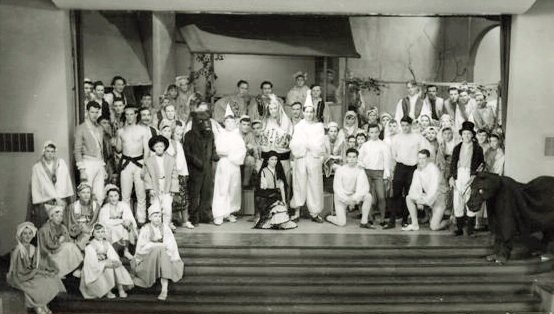
The Circus Troupe
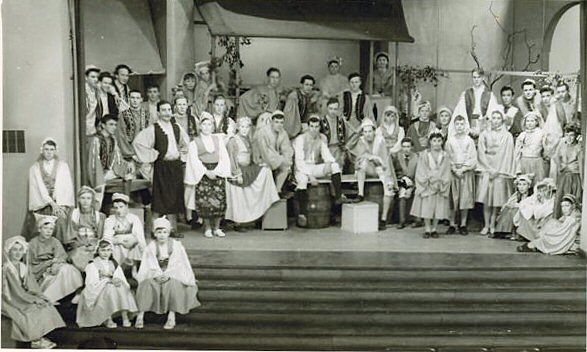
Chorus of Villagers
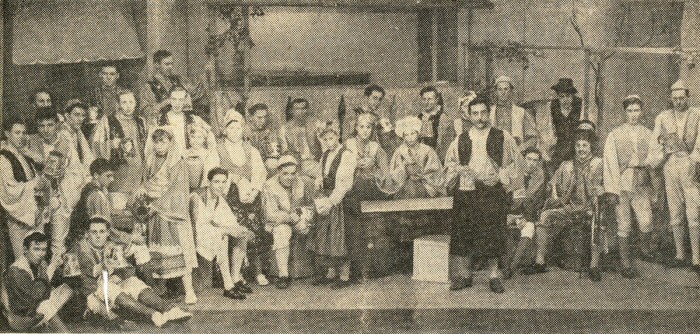
Another photo of the cast - do you have an original - this came
from an old newspaper cutting - source Norman Long
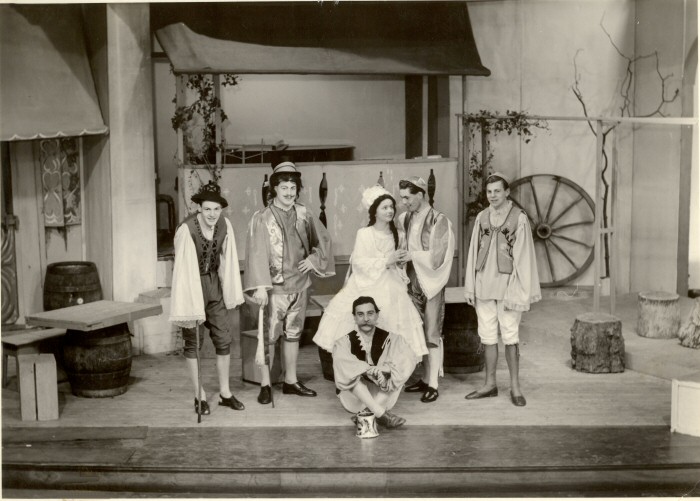
back: Maurice Human - Robert Hinze - Stuart Poole - John Newman -
David Crowe. front: Mr J Grassi (source: Waller)
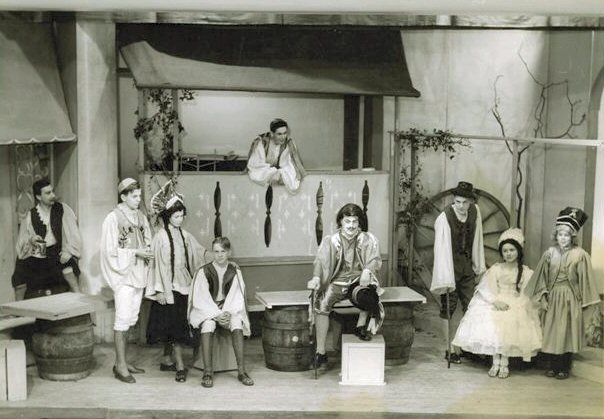
Mr J Grassi - D Crowe - N Long - D Banyard - J Newman - R Hinze -
M Human - S Poole - A Christie
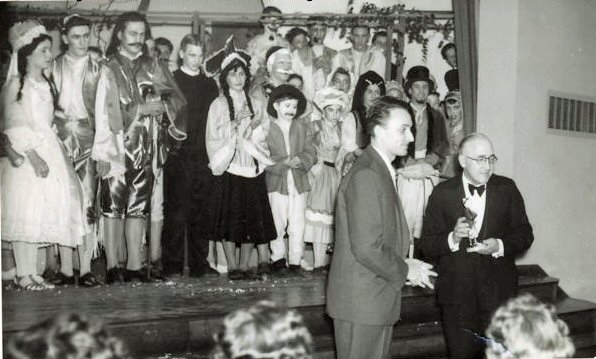
The Cultural Attaché from the Czech Embassy presents
Mr Armitage with a statuette of Kecal the Marriage-Broker
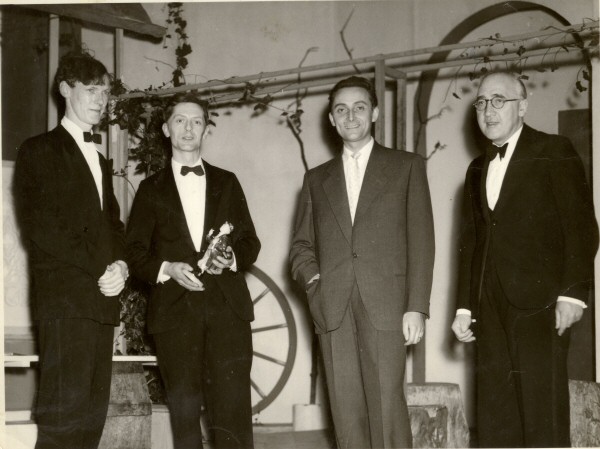
L-R: Mr Hugh Stalker - Mr Rex Waller - Czech Cultural Attaché -
Mr Edward Armitage
source: Rex Waller
If you have more photographs or other reviews for this production, please contact the editor
programme source: David Cross (1954)
images: Robert Hinze (1952)
Times cutting: Richard Walker (1964)
page last updated 24 Mar 2010